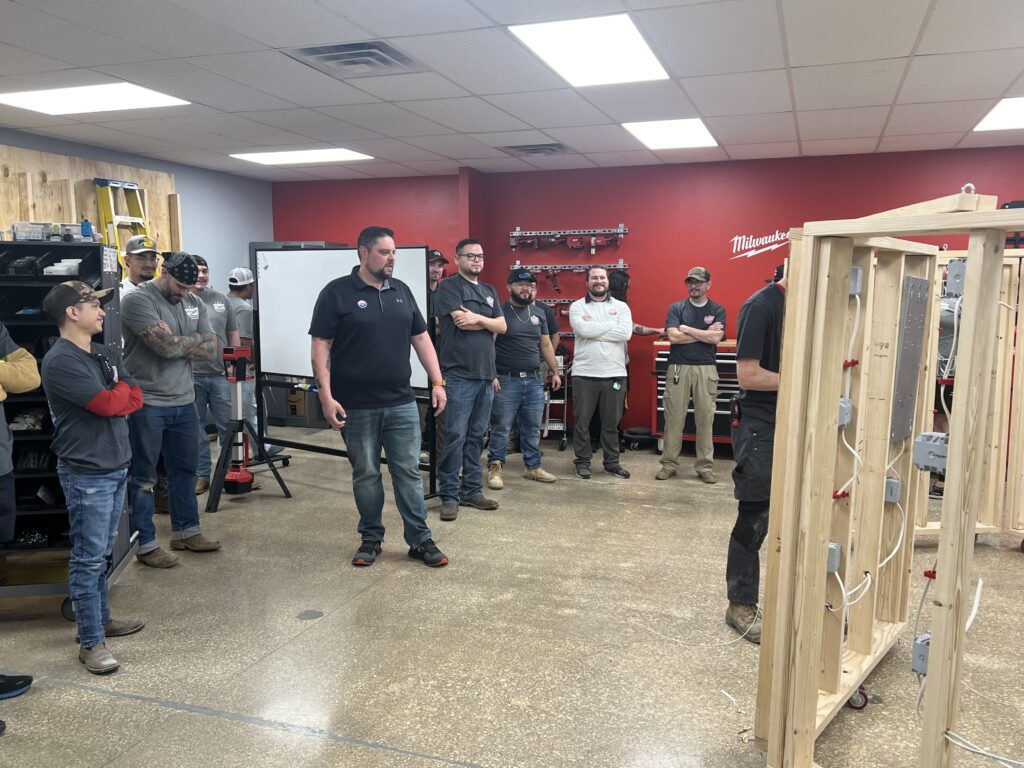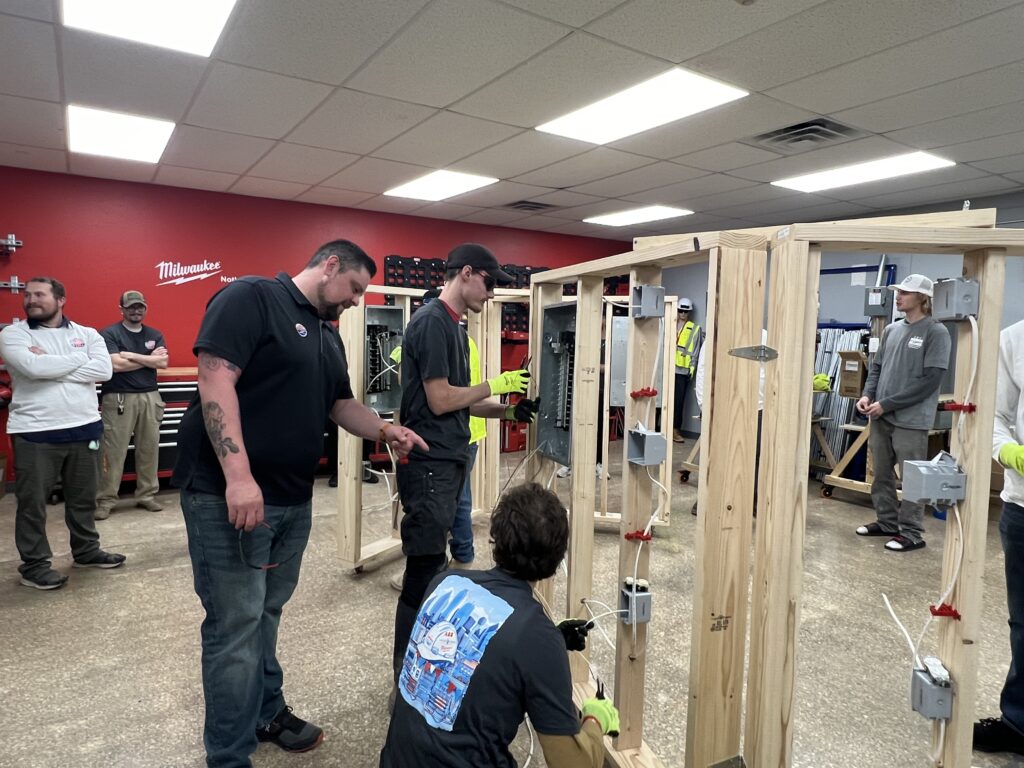By IEC Staff
What does it take to be named the IEC National Instructor of the Year?
IEC Dallas Executive Director Erin Stewart nominated Paul Lozoya and, in the application, she said, “Paul Lozoya’s journey in the electrical industry has been marked by perseverance, continuous learning, and a genuine desire to empower others. His commitment to excellence, both as an electrical inspector for the City of Dallas and as an apprenticeship instructor with IEC Dallas, has made a significant impact on the lives of countless aspiring electricians.”
After speaking with Paul, IEC Insights saw many attributes that helped Paul win this honor. High on the list would be trade knowledge, a willingness to keep learning, belief in the IEC Apprenticeship Program, the ability to be patient, compassionate, and creative with students, and an unwavering desire to see things through to completion.
Never Quit
That last one — an unwavering desire to see things through to completion — could pretty much summarize any one of Paul’s accomplishments to date.
 “My dad was a sign inspector for the city of Dallas, and sometimes I would go to work with him,” Paul remembers. “I used to think, ‘hey, that’s a pretty good way to make a living; I want to do that.’”
“My dad was a sign inspector for the city of Dallas, and sometimes I would go to work with him,” Paul remembers. “I used to think, ‘hey, that’s a pretty good way to make a living; I want to do that.’”
That thought continued as Paul went through middle school and high school. His father was supportive, continued to take him to jobs to see the work and meet other city inspectors, yet guided him in a slightly different direction by encouraging Paul to become an electrician so he could do what he did — and more.
Paul says he signed on with Masters and Associates to pursue the electrical field right out of high school in 2005. It was not at all what he expected.
“It was June of 2005 and the usual 110-degree day in Dallas. I was assigned to a theater build out on the northeast side of Dallas working on the top deck underneath the metal roofing running conduit,” Paul recalls. “It was about 120-130 degrees up there. That was a rough awakening of what an electrician does. This was not easy, nor was it fun. I am a bigger guy —and I was up there sweating. This was not how I remembered the trips working with my dad.”
When Paul showed up again for work the next day, his superintendent actually was a bit surprised. He told Paul he had been pretty certain that after his grueling first day that Paul would decide to pursue a different career.
“That’s not who I am,” Paul says in hindsight. “I never give up. I don’t stop. Once I have something in place, I just go for it. I always figure out how to adapt and go for it.”
That attitude served Paul well as he continued his career trajectory. Seeing great potential in Paul, company leadership offered to put him in IEC Apprenticeship that first year. Paul opted not to do so. The next year at his annual review, he learned that if he wanted a pay raise, he’d need to enter the program. Paul did and knows it was a smart move.
His classmates remain his friends today and just like in class, they support and encourage one another on the job. His young career has involved stints at contractors Walker Engineering and Caddell Electric and, yes, a seven-year run as an electrical inspector for the City of Dallas. He left the city as assistant chief electrical inspector in March 2023 to take on his current role as IEC Dallas training director.
Teaching Feels Right
As Paul was working his way to city inspector, there was still a missing piece to his career puzzle. That came to life in 2017 when then IEC Dallas Training Director Joe Chandler asked Paul to cover a first-year mid-term class.
“I was kind of thrown into it, no real training,” Paul says. “I really liked it and was teaching two classes a week for four months.”
Following that mid-term role, Paul was hooked. He loved how much he was learning while teaching and when Joe asked him to continue and wanted to know what year he’d like to teach, Paul selected second year.
“There is lots of code in second year,” Paul explains. “I love code. I had the experience as a city inspector, but I learned that I did not know what I was talking about! I wanted to get better at teaching it to students who really had no background or experience with it. I started by doing each lesson’s homework about three or four days in advance of class. If I am going to teach it, I have to know it.”
One realization Paul had early on was that he had to remember that many students in his class were being exposed to these topics for the very first time — they had no experience whatsoever so he needed to think about how to best present the lessons. Paul put a lot of effort into that.
“One thing that works for me is to always find out what my students like to do, what their hobbies are, what excites them,” he explains. “For example, the math can seem a bit overwhelming in the lessons on parallel and series circuits. I learned a lot of these guys liked to play with sound systems in their cars so I made these lessons about how to correctly wire up their subwoofers. That is 100 percent parallel and series. The same applied to those who liked working on cars — I try to find real-life scenarios where you apply ohms law outside of the electrical trade. I would teach them the math behind car basics. Whenever they went home and troubleshooted their cars, they could do it themselves because the rules never change. Ohms law is still ohms law no matter where you apply it. Volts and amps and watts in our lessons are the same as volts and amps and watts when you’re trying to boost the power in your cars. I told them, imagine your gas pedal is the amperage, your fuel pressure is the voltage, and your horsepower is the watts. When I’m idling, my amperage is extremely low but my fuel pressure is constant because the fuel pump is always activated. It’s always there. As I press that gas pedal down, my amperage increases and now I get more horsepower. I always try to find things like that to help them understand the math behind what we do.”
and series circuits. I learned a lot of these guys liked to play with sound systems in their cars so I made these lessons about how to correctly wire up their subwoofers. That is 100 percent parallel and series. The same applied to those who liked working on cars — I try to find real-life scenarios where you apply ohms law outside of the electrical trade. I would teach them the math behind car basics. Whenever they went home and troubleshooted their cars, they could do it themselves because the rules never change. Ohms law is still ohms law no matter where you apply it. Volts and amps and watts in our lessons are the same as volts and amps and watts when you’re trying to boost the power in your cars. I told them, imagine your gas pedal is the amperage, your fuel pressure is the voltage, and your horsepower is the watts. When I’m idling, my amperage is extremely low but my fuel pressure is constant because the fuel pump is always activated. It’s always there. As I press that gas pedal down, my amperage increases and now I get more horsepower. I always try to find things like that to help them understand the math behind what we do.”
He said he also looks for various ways to build and instill confidence in his students. Sometimes that’s playing to their competitive nature and sometimes that’s just stepping back a bit.
“Maybe it’s the teaching methods, or maybe they’ve got something going on in their personal lives that’s holding them back,” Paul says. “I’ve found that the top 10 percent in every class I’ve taught will excel no matter what. I try to look harder at those below them who are struggling a bit and see if there is anything I can do to help them to the next level. I think there has to be compassion in teaching along with the strict words.”
One ‘extra’ teaching method that really worked for him was during his years as a Dallas city inspector. Paul says when going to job sites where companies his students worked for would be, he always sought out the foreman first and asked that one or more of his students ‘walk’ the site with him during the inspection. He used this as another means of getting his students to think. He’d ask them ‘what am I looking for here?’ or ‘why was this done this way?’ or ‘how did the code impact this?’
“This helped them see the connection between the classroom learning and work on the job site,” Paul explains. “It got them thinking and, yes, their confidence grew as they saw all the things they did correctly. And when a second year could answer a question before a fourth year — because they had covered that topic more recently — confidence really grew.”
The Next Step: Training Director
Paul is super excited about his role as training director for IEC Dallas. There are 16 instructors for the IEC Apprenticeship Program, including Paul, and they are just shy of 700 students first semester 2024. There also are two additional instructors to handle the continuing education and prep (journeyman and master) classes that are offered through IEC Dallas that fall under Paul’s responsibility as training director. Paul says that with the support and direction of IEC Dallas Executive Director Erin Stewart, they’ve been making a number of improvements.
“The IEC curriculum is the backbone, but we work very hard to cater it to the work in our area,” Paul says. “We’ve remodeled and upgraded our labs. Our motor control boards were the same ones I worked on as an apprentice so now we’ve totally revamped them. We’re striving to make things current and make it exciting for our apprentices. In fact, I wish I were a student now!”
The IEC Dallas Apprenticeship Program is the standard IEC four-year program with required 8,000 hours of on-the-job training and 576 hours of classroom work.
“One of the things I like most about my instructor role is seeing when that ‘switch’ goes on for a student — from thinking they’d like to become an electrician to seeing them start loving the career they are building,” Paul says. “That often comes as they get into the problem-solving aspect of our trade. They begin to take ownership of the situation and are proud of what they are accomplishing.
“You don’t have to try to be the best I tell them, but be better than what you were yesterday. And, keep learning! That’s what I tell my students all the time.”
Paul’s Hobbies Make Him a Better Electrician and Instructor
Remember how Paul said he tries to find out about his students’ hobbies so he can use that as an inroad to what gets them excited? High on Paul’s hobby list is that he likes to ‘take stuff apart and rebuild them’ — Legos, PCs, and cars, especially cars.

“I’m a big import guy, and my pride and joy is the 1971 Datsun 521 truck that my dad and I rebuilt totally over 11 years,” Paul says. “That project taught me a lot about saving, patience, understanding, and temperament as we often had to wait several paychecks for Dad to have the funds to buy that next part we needed. We won several first places with that car at Autorama.”
Paul’s current car project is an Acura TLX Type-S, which he squeezes in around work, traveling with his wife Melanee, and family adventures.
“I’m also a gamer and have been ever since my dad bought me that Super Nintendo back in elementary school.”


